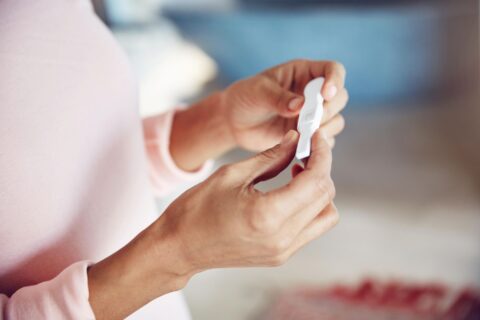A weak pelvic floor is no laughing matter, but personal trainer Lynda Lovatt is here to help. Juliet Young reports.
Lynda Lovatt chortles as she remembers the humiliating day that led to her passion for educating women about pelvic floor health.
On a family trip of a lifetime with her husband and two children at California’s Disneyland, Lynda burst out laughing when she witnessed people flying in all directions to avoid a huge bee that was harassing lunch goers around her.
“I lost it and couldn’t stop laughing. There I was with a full bladder in a summer dress and then the floodgates opened. I was powerless to stop the flow.
There I was with a full bladder in a summer dress and then the floodgates opened.
“I had to tie a top around my waist for the rest of the day and then I was off to an LA chemist to get some Tena pads.”
Lynda had experienced leakage for a few years but had hidden it well, wearing clothing that would disguise the problem, avoiding high-impact activities and choosing carefully when to drink alcohol, which is a muscle relaxant.
While working with elderly women as a nurse, she had seen many reliant on pads. After the Disneyland incident, Lynda reluctantly began wearing pads herself, but she knew that wasn’t going to correct the problem.
Back in Wellington, Lynda resolved to face the issue and began her journey by going to a women’s health physio, avoiding impactful workouts and doing exercises to strengthen her pelvic floor.
Lynda says pelvic floor issues are common, affecting one in three women. “This muscle is so important but no one talks about it,” she says. “There is very little out there to help women with postnatal exercise.”
Lynda’s issues were compounded by exercise. In 2007, after having two children, she took up fitness to “get my body back”.
She says postnatal women often choose intense exercise they can do quickly, like running, because they are time poor. “They don’t realise that high-impact training is the wrong type of exercise, because it is putting a lot of pressure on their pelvic area.”
Lynda began running 5km and 10km events, then worked up to half marathons. She also got into gym weight training and exercise programmes.
“I had never done exercise at this level before. It was a shock to my body. I became addicted to the exercise buzz. I was training every day. I lost weight and was gaining muscle. I was achieving my goals and I loved it.
“What I didn’t know was that my pelvic floor was getting a thrashing at the gym, during running and at home doing all the things a mother does.”
Pelvic floor muscles support the bladder, uterus, rectum and important abdominal organs against gravity and any added downward pressure. If they’re not functioning well, people experience incontinence and leak urine when they laugh, sneeze, cough or do impactful exercise such as running or jumping.
Lynda says she was very fit and couldn’t understand why her pelvic floor had issues. On seeking help she learnt that her pregnancies and birth deliveries were to blame for her incontinence problems.
Her first child was born with ventouse suction after a long labour as the baby presented posterior (facing the wrong way). Lynda had a vaginal tear and bleeding during the birth. She chose to have a Caesarean section for her second child 22 months later.
Lynda says her birth experiences ticked all the boxes for pelvic floor dysfunction, but she didn’t know this until it affected her daily life with incontinence. She says all women who have given birth need a pelvic floor health and birth history assessment.

“I experienced first-hand that if this muscle is damaged and unable to do its job it can cause ongoing social and health issues,” she says.
A registered nurse with 13 years’ experience, Lynda pivoted into personal training in 2010, and, motivated by her experience with incontinence and passion for exercise, began developing a postnatal recovery programme for women in 2013.
“When I went to the gym to recover my body after childbirth, no one asked about the main group of muscles in my core that is affected by childbirth – the pelvic floor muscle. And in the personal training I have done, the pelvic floor is not mentioned anywhere.
It struck Lynda that almost half the population give birth so are affected by pelvic floor issues that are usually left untreated for the rest of their life.
“The more I learnt, the more I realised that the focus of my business was to provide pelvic floor safe exercises to enable women to recover and enhance their health.”
Lynda now delivers a postnatal recovery programme from her Wellington studio with both in-person and video classes, and provides her programme to fitness professionals across the country.
“I want women and fitness professionals to know that there is help available, that they can recover and they can prevent these health problems occurring.”
Lynda’s Puff Fitness Postnatal Recovery Programme was recognised at the New Zealand Exercise Industry Awards with a Programme Excellence award in 2017, and as a finalist in the Innovation of the Year in 2020.
Lynda’s story is not unusual. Statistics show that one third of women experience bladder leakage.
The stats on pelvic floor issues
- 25 – 45% of all adult women experience urinary continence. (Source: ICI (International Consultation Incontinence) guidelines, 2013)
- 1 in 3 women who have had a baby will experience urinary incontinence.
(Source: Thom & Rortveit, 2010) - 1 in 10 women who have had a baby experience faecal incontinence.
(Source: Johannessen, 2017) - 1 in 12 are symptomatic prolapse. (Source: Barber, 2016)
- 1 in 5 experience pain with intercourse. (Source: Glazener, 2013)
- More than two thirds of women with postpartum urinary incontinence and one third of women with faecal incontinence still report symptoms 12 years after delivery. (Source: Glazener, 2013)
Risk factors for developing weak pelvic floor muscles
- Pregnancy and childbirth
- Constipation or persistent straining
- Ageing
- Obesity
- Menopause/hormonal changes
- High-impact sports or heavy lifting
(Source: Physiotherapy NZ)
A common complaint: ‘I had no idea of the risks’
Wellington pelvic health physiotherapist Liz Childs treats a range of pelvic floor health issues for both men and women.
The conditions she sees most in women are bladder, bowel, pregnancy and postnatal issues, and those brought on by menopause and ageing. Common issues include bladder leakage, bowel control problems and constipation.

Liz says there are many effects on women, with one in four New Zealand women reporting that urine leakage affects their participation in sports and going the gym.
“Another example of how it affects people’s daily life is that some patients won’t leave their house until they have had a bowel motion due to fear of faecal incontinence. That is quite debilitating,” she says.
Others have sexual problems with reduced sensation, pain and relationship issues. Liz says there’s a strong link between pelvic floor dysfunction and mental health issues, and another burden individuals and whānau shoulder is the cost of pads, time off work and medical treatments.
Liz’s practice sees 1200 new patients a year and the number is growing. Of the 170 patients her team sees a fortnight, many say they wish they had known they had an issue and could get help sooner.
The physiotherapist says there is a big lack of awareness that pelvic health issues exist and about the importance of healthy pelvic floor function. “People tell me they wish they’d known about us sooner,” she says.

People tell me they wish they’d known about us sooner.
One patient of Liz’s is a Wellington mum of three. The woman, who asked not to be named for privacy reasons, has diastasis recti, a condition where the abdominal muscles separate following childbirth.
She says she experienced lower back pain after her second child and on the recommendation of a work colleague went to see Liz, and subsequently Lynda Lovatt for supervised exercises. Before having children, the woman loved running and her goal is to get back to that when her core is stronger.
She says New Zealand’s maternity care is poor and she believes there should be more information and funded care available. She didn’t know about pelvic floor issues until experiencing her own problems.
“You actually get a couple of pamphlets and that is the only information that is given to you. It’s shocking,” she says.
The woman points out that in France women are provided subsidised visits with pelvic floor physiotherapists before and after birth. Still on a waiting list to see a pelvic floor physiotherapist in New Zealand’s public health system after nine months, she worries about mums who can’t afford to go private.
Her third child is six months old. After attending weekly sessions with Lynda for two months, the woman says her back pain was gone. “I found it really helpful. It taught me how to cognitively connect with my pelvic floor when I am exercising so it becomes something that is intuitive.”
But it is still a long road to recovery and she has been advised it could take another 12 months before she can get back to running.
Another mum who experienced prolapse, and wished to remain anonymous, says more education is needed for impending and new mums. “I had no idea of the risks of going back to high-impact activities without strengthening your pelvic floor after childbirth. I had an obstetrician and a midwife and no one mentioned it to me.”
She says pelvic floor education should be offered through the lead maternity carer, Plunket or in antenatal group classes. “The damage can be minimised if people know a bit more about it,” she stresses.
The mum of two experienced leaking before seeking help from a pelvic floor physiotherapist. The treatment unearthed damage from her first birth which caused prolapse.
She says her condition had been particularly debilitating and she’s found it very mentally challenging, especially being stuck at home and unable to even go for a walk without feeling pelvic heaviness.
“I have joined a lot of online groups here and overseas,” she says. “That
has highlighted to me that so many women have these problems, but people struggle to talk about it because it’s so personal.”
Raising awareness of pelvic health
There are moves to raise awareness of pelvic health and improve funding and support for pre and post-birth care for women.
A pelvic health online petition which gathered 55,000 signatures was presented to Health Select Committee member and Ilam MP Sarah Pallett at Parliament in July. The petition was organised by personal trainer Kirsty Watt who believes women aren’t getting the care they need after giving birth.

Along with pelvic health physio-therapist Liz Childs, Kirsty is part of a multi-disciplinary group of professionals which has been working to develop some clear goals for the government. Chair of the working group is University of Otago Emeritus Professor of Obstetrics and Gynaecology Don Wilson. He says the government could improve the situation for women by providing assessments and physio treatment, and better preventative education on pelvic floor disorders relating to pregnancy and childbirth.
The group recommends prevention strategies including pelvic health physiotherapy and pelvic floor muscle training with all maternity care providers working together with the goal of prevention. He says these are the most cost-effective interventions for treating mild to moderate incontinence and prolapse.
The group supports Kirsty’s petition, calling for more funding for Continence NZ, which runs a free helpline staffed by experienced continence nurses, and provides information and workshops for fitness professionals.
The petition was referred to the Petitions Committee in August along with a submission.
Continence NZ Executive President Dr Anna Lawrence agrees with the working group. She says the helpline provides women with information and advice, and Continence NZ is developing a guide with essential advice for pregnancy and post-birth, but more work is needed to support women.
“A multi-disciplinary approach to pelvic health care is critical if we are to enhance outcomes for women,” she says.
In mid-September, Green Party MP Jan Logie wrote an open letter to ACC Minister Carmel Sepuloni asking that ACC cover all birth injuries and traumas. In two weeks, the letter had gathered 36,800 signatures of support.
In late September, Carmel announced that the government was proposing to amend legislation to cover more injuries experienced by women during childbirth. The Accident Compensation (Maternal Birth Injury and Other Matters) Amendment Bill will be introduced to Parliament later this year, and people can comment on the proposed changes when it goes through Select Committee from early 2022.
Liz says the proposed ACC changes are separate to the working group’s submission, which emphasises education and prevention measures for all pelvic floor issues before and after birth, and is still due to be put before the Health Select Committee.
She says pelvic health issues are underdiagnosed and undertreated.
Statistics show that 46% of older women experience at least one major type of pelvic floor dysfunction.
“It reaches epidemic proportions,” she explains. “One of the problems is that bladder leakage is considered as being normal after having children, but it is not – it is common, but it is not normal.”
In a 2013 study by Physiotherapy New Zealand, 56% of respondents thought that urine leakage was a normal part of getting older. “People don’t have to put up with it. There is treatment,” Liz says.
Adding to the problem is that many people are too embarrassed to talk about their incontinence. When asked in the same survey, 20% of people said they were uncomfortable to talk to a health professional about it.
Liz says awareness needs to be raised among other health professionals who are not always aware of what pelvic health physiotherapists do or that they should refer patients. She also notes that questions about pelvic health are not routinely asked in health checks, so they often go under the radar.
“We know that pregnancy and childbirth are major risk factors for pelvic floor dysfunction. I’d love to see all New Zealand women have access to the right pelvic health care during the perinatal period.
“I want to empower women, give them the knowledge they need to care for their pelvic floor for life, so that they can live the lives they want to, free from the burden of pelvic floor dysfunction.”








